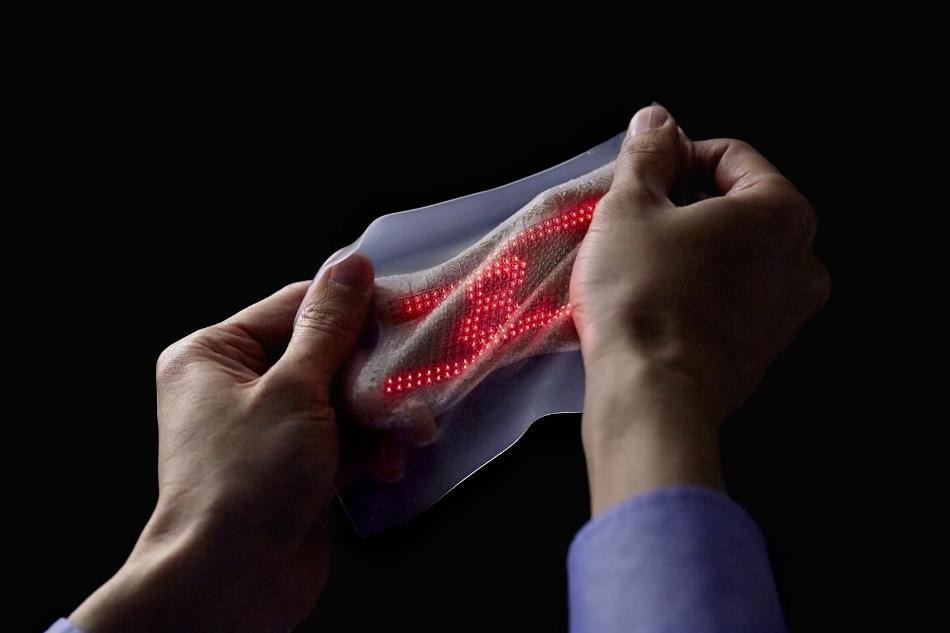Feb 19 2018
An innovative ultrathin, elastic display that comfortably fits on the skin is capable of showing an electrocardiogram’s moving waveform recorded by a breathable, on-skin electrode sensor. This integrated biomedical sensor system together with a wireless communication module is known as "skin electronics," which can send biometric data to the cloud.
 The soft, flexible skin display is about 1 millimeter thick, and consists of a 16 x 24 array of micro LEDs and stretchable wiring mounted on a rubber sheet. It can withstand repeated stretching, by as much as 45 percent of its original length, without showing any loss in function of its electrical and mechanical properties. (Credit: 2018 Takao Someya Research Group.)
The soft, flexible skin display is about 1 millimeter thick, and consists of a 16 x 24 array of micro LEDs and stretchable wiring mounted on a rubber sheet. It can withstand repeated stretching, by as much as 45 percent of its original length, without showing any loss in function of its electrical and mechanical properties. (Credit: 2018 Takao Someya Research Group.)
The research work by a Japanese academic-industrial partnership, headed by Professor Takao Someya at the University of Tokyo's Graduate School of Engineering, was scheduled for a news briefing and speech at the AAAS Annual Meeting in Austin, Texas held on 17th February.
Thanks to developments in semiconductor technology, health can now be monitored using wearable devices by first determining vital signs or recording an electrocardiogram, and then sending the information wirelessly to a smartphone. The electrocardiogram waveforms or readings can be shown on the display in real time or transmitted to either a memory device or the cloud where the data is stored.
The researchers aim to further develop this skin electronics system by improving data accessibility for people like the elderly or the sick, who may find it difficult to operate and obtain information from existing devices and interfaces. Through continuous, non-invasive monitoring of health and self-care at home, the system can help ease the burden on home healthcare systems in aging societies.
The new integrated system features a flexible, deformable display and a lightweight sensor consisting of a breathable nanomesh electrode and a wireless communication module. Medical information recorded by the sensor, such as an electrocardiogram, can either be transmitted wirelessly to a smartphone for further analysis or to the cloud for storage. In this work, the display demonstrated a moving electrocardiogram waveform that was saved in memory.
The skin display, created by a partnership between scientists at the University of Tokyo's Graduate School of Engineering and Dai Nippon Printing (DNP), a major Japanese printing company, is equipped with a 16 x 24 array of micro LEDs and stretchable wiring fitted on a rubber sheet.
Our skin display exhibits simple graphics with motion, because it is made from thin and soft materials, it can be deformed freely.
Professor Takao Someya, Graduate School of Engineering, University of Tokyo
This display can be stretched by as much as 45% of its initial length.
Compared to previously developed wearable displays, the new skin display shows far more resistant to the wear and tear of stretching. It is built on an innovative structure that reduces the stress caused by stretching on the juncture of soft materials, such as the elastic wiring, and hard materials, like the micro LEDs - a major reason that causes damage in other models.
The biomedical sensor system is the first stretchable display that shows better durability and stability in air, such that not even a single pixel failed in the matrix-type display while fitted comfortably onto the skin and constantly subjected to the contracting and stretching motion of the body.
It is possible to wear the nanomesh skin sensor continuously on the skin for a week without any fear of inflammation. This sensor, designed in a previous study, had the ability to measure pressure, temperature, and myoelectricity (the electrical properties of muscle). However, in the latest research, the sensor was able to successfully record an electrocardiogram for the first time.
The collaborative team applied tried-and-true methods employed in the volume production of electronics- particularly, screen printing the silver wiring and fitting the micro LEDs on the rubber sheet using a chip mounter and solder paste widely used in the manufacture of printed circuit boards. Using these methods will probably expedite the commercialization of the display and help control future production costs.
DNP is planning to introduce the integrated skin display to the market within the next three years by enhancing the reliability of the stretchable devices by optimizing its structure, improving the production process for better integration, and addressing technical challenges such as wide-area coverage.
The current aging society requires user-friendly wearable sensors for monitoring patient vitals in order to reduce the burden on patients and family members providing nursing care. Our system could serve as one of the long-awaited solutions to fulfill this need, which will ultimately lead to improving the quality of life for many.
Professor Takao Someya